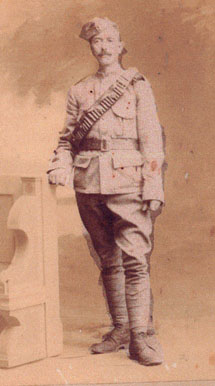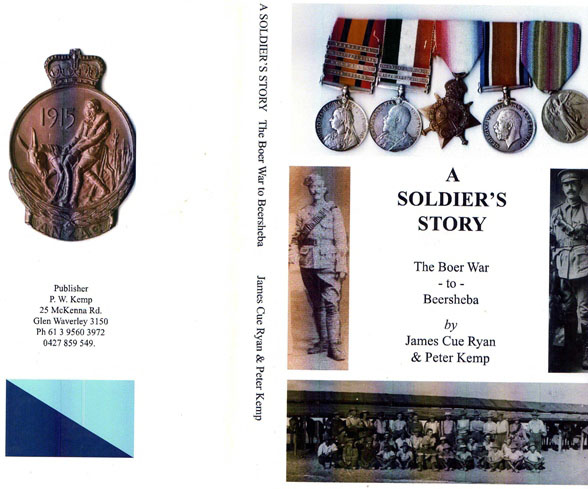Klerksdorp.
20 February 1901
Time has sped with fleeting wings and events of import have followed in its trail since we learned Lord Methuen’s intention of “striking hard” at Hartebeestefontein.
The stiffest fight the A.I.R. [the Australian Imperial Regiment, formerly the 4th Victorian Imperial Bushment Contingent] has had a hand in is now a matter of history and its consequent death roll appeared at the time of writing in the Australian press. With the 3rd Imperial Yeomanry in the advance guard, the 10th I.Y. as supports and the A.I.R. third position in the column. Methuen’s men cautiously advanced from Paarde Plat at daylight. The first three or four miles traversed comprised open veldt, acres of green mealies as high as the saddle produced a delightful effect to the vision. To our immediate front and on either flank mountains pierced the grey overhanging mist. A defile led through these and it was our “pass” to Klerksdorp.
But “twas 1pm ere we sighted Hartebeestefontein though 8am saw us in a mile of it. The Boers, Limburg and De Truit had rallied 1900 men on Hartebeestefontein heights and according to the townspeople, these two other leaders, whose names I cannot glean, were so bubbling over with bombast as to declare that the British have had their day. Each commander was in his allotted place and received his orders with clock like regularity. Each battalion moved up to its appointed place and the guns swung merrily around. Our abnormally large convoy, 8 teams deep, halted, and as matter stood remained in status quo for the next five hours. Suddenly there came the sound as if of a rushing wind. No doubt some of breathed a trifle hard, we were all expectancy, human targets for the invisible Boer gunner. S-w-i-s-h! He is long sighted.

The contents of the enemy’s nine-pounder Krupp sweep harmlessly o’er our heads and find rest among a flock of sheep way back to the rear. It and half-a-dozen to follow went a-begging. The sheep grazed peacefully on, and even the equanimity of a team of army mules was not disturbed though one missile landed adjacent to their traces. From their position to the column the I.Y. were first across a mile of ploughed land and up the face of a hill under brisk rifle fire where on a convenient hollow sheltered the horses.
Awaiting the word of command both squadrons A.I.R. jumped off the mark and each man vied with the other as to the prowress of his horse. The country hereabouts is fearfully treacherous and many a horse and rider kissed mother earth through the agony of ant-bear holes. These spills are now looked on as mere trifles, though many a nasty sprain is the result. Our pace was severe (no doubt there would be no “pulling”, riders were greeted with showers of lead in the advance and the finish post spelt sanctuary!) and we came up with the Imperial Yeomanry. “Advance with the Australians,” was their commanding officer’s order, and at the double with backs bent the summit was soon gained. There was a superabundance of whistling lead here but it was all high. The Yeomanry inclined to the right, B squadron A.I.R. to the left and A squadron occupied the immediate front of a position horse shoe in shape with the Boers in the open end in a hollow and on either flank behind sangers and natural protuberances.
The shelter in the British firing line was an unknown quantity; mayhap a few blades of grass served to hide a prone body. The Boer name was legion and they were sitting tight from point blank range up to 600 yards sight. In the firing line and what they thought were unassailable positions they outnumbered the British by three to one. One of the North Lancs. has since informed me that their rifle fire was as heavy as any encountered at the battle of Graspan, yet our men with their home compatriots not alone stood their ground but contested that of the enemy inch by inch. Were there such a warm spot as a material hell one could imagine its gates were open wide on this morn of the 18th February. Our 15 pounders and a couple of pom poms ascended the summit of the first hill.
Our shrapnel ploughed the kopjes, and the din of these with the echo of the Boer pom pom reminded one forcibly of Dante’s inferno. Many and varied were the rifles used by the Boers. Their Martini fire finishes slowly like a spent bullet; their Express rifles all carried wail like a human and in agony; our weapons best time with crack, crack, crack, and three hours of the mowing down process sped on, while, with the exception of a field of carnage, neither Briton nor Boer had got any forrader.
Our field pieces were withdrawn from an exposed position; a couple of gunners had gone down, and the big weapons were riddled; some 30 of the North Lancashires were ordered up from convoy guard and filed into their places under leaden hail as though they were entering the Alhambra. Without a doubt Britain’s Tommies are her staple products. They knew not the meaning of fear; they consider it part and parcel of their duty to stand up and be shot down. Did the craven Boer posses one-tenth of their grit Pretoria would still be the capital of the Transvaal Republic.
An officer standing up directing operations motioned one of his men to lie down and met with the response -“Are you made of cast iron which enables only you to stand?” The Tommy was spread lifeless a couple of seconds after completing the sentence. The officer (Lieutenant —–) showed us how brave men can die. “Come with me lads” and he proceeded to advance fairly into the enemy’s ranks, the only means of obtaining a view downwards of the foe. A bullet pierced his brain and the men continued operations. One lad was shot through the heart while his hand was yet on the bayonet hilt where it remained after life’s struggle was over. In all ten were killed or wounded in one spot out of a score of Lancers. But these noble men did not perish in vain.
From this out of the Boer ranks wavered, though our men were dropping like ninepins. Surgeons and ambulances men were flitting here and there under a raking fire in performances of their meritorious duties, in fact the stretcher bearers might be said to form a procession from the firing line down to the hollow where horseholders had charge of the animals. Even these latter did not escape, as a Boer sniper had previously stationed himself somewhere in the rocks commanding a view of the hollow and rendered two of the animals hors de combat before he was luckily located.
It was now 12 noon and the battle had been raging without cessation for four hours. Lords Methuen and Errol were on the ridge in the thick of the fight; Captain Chalmers* led the A.I.R. still further forward (Colonel Kelly had already fallen)**; the Imperial Yeomanry and the little band of heros from the Tommies ranks essayed another advance, when the shout rang out “They’re retiring!” “Who’s retiring?” asked Lord Methuen! “The Boers sir!”

* Captain Henry Black Chalmers, from Gippsland.
**Colonel Nicholas William Kelly, the Commanding officer, badly wounded in the thigh.
Contact PeterKemp about this article.






